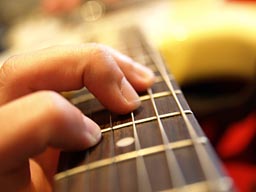Musician’s Injuries

What are Musician’s Injuries?
Musician’s injuries are repetitive strain injuries commonly seen in musicians due to placing repetitious force on their hand and arm ligaments, as well as the muscles, joints, nerves, and tendons. This can cause inflammation, swelling, pain, and a reduced range of motion in the affected fingers, hand, wrist, elbow, and arm.
Hours of practice and performance for long periods of time with insufficient rest using the same muscle groups may result in a common set of injuries to the hand and arm structures.
Types of Musician’s Injuries
Any repetitive motion from an insufficiently conditioned or ergonomically incorrect body position has the possibility to result in strains and pains in the musculoskeletal units of the arm. Tenderness, pain, and micro tears can occur. Any musician who plays or practices solo or with a band or orchestra has the potential to suffer from a variety of repetitive strain injuries to the hand, wrist, and or elbow.
Some of the most common injuries seen in musicians include:
- Carpal tunnel syndrome and flexor tendonitis: numbness and tingling in the hand, wrist, fingers and arm.
- Cubital tunnel syndrome: pressure or stretching of the ulnar nerve.
- De Quervain’s tendinitis: painful inflammation of specific tendons that extend the thumb.
- Drummer’s tendonitis: inflammation or irritation of a tendon to the thumb at the wrist.
- Extensor carpi ulnaris tendinitis: inflammation of the extensor carpi ulnaris tendon (pinky side of the wrist).
Characteristics and Clinical Presentation of Musician’s Injuries
Some patients report numbness and tingling in the affected region extending from the wrist to the elbow. Patients may not be able to use their fingers, wrist, or elbow efficiently, depending on the severity of the injury. Additionally, patients may have difficulty performing pressing, plucking, grasping or pinching movements with their hand.
Other symptoms of musician’s injuries include:
- Radial sided (thumb) wrist pain.
- Swelling in the hand, fingers or wrist.
- Tenderness to palpation of the distal forearm and wrist, thumb side.
- Decreased wrist flexion or extension.
Causes of Musician’s Injuries
Any repetitive movement of the thumb, wrist, or elbow can put strain on the tendons in these regions. Tendinitis is typically an injury resulting from overuse and is more likely to develop over time.
Nerve compression due to incorrect positioning or differences in congenital anatomy and structural variation is sometimes a precursor to musician’s hand injuries. Some musicians may be at increased risk for injury due to genetic predisposition.
Getting a Diagnosis for Musician’s Injuries
A careful physical examination of the affected area is central to making an accurate diagnosis. An X-ray is beneficial in evaluating abnormalities of the affected joints, while a nerve test (NCS) may be ordered to obtain details about the health and performance of the nerves. Additionally, an MRI may be required to evaluate the condition of the tissue surrounding the sore area.
Treatment Options for Musician’s Injuries
A careful examination and diagnosis is crucial to an appropriate treatment plan. Ergonomic analysis and improvements to a musician’s technique may be beneficial in attempting to reduce future injury. The surgeons note the pieces they play to further assess the forces they apply. Musicians sometimes suffer from nerve entrapment such as carpal tunnel syndrome and cubital tunnel syndrome, which may require surgical intervention depending on severity.
Conservative Treatments
Most mild conditions can be treated with treated with splinting of the affected region, rest, icing, and anti-inflammatory medication. Resting between practice and icing an at risk area can also be helpful in some cases in preventing long-term damage. If the pain is acute, players should seek immediate medical evaluation.
If your hand surgeon gives you clearance to move forward with conservative treatments, you will discuss:
- Prudent playing agenda.
- Ice affected region for 7-10 minutes to reduce swelling and discomfort in the area.
- Rest affected region for a time arranged with your hand surgeon.
After this period, many patients can begin early controlled motion and practices to ease the region back.
Surgical Treatments
Severe instances may benefit from a corticosteroid injection or possibly surgery to repair damaged tendons or sheaths. The treatment of the affected region depends on the severity and duration of the condition. Nonsurgical or surgical repair of the affected region can be combined with occupational therapy to maximize success.
Preventing an Injury as a Musician
Ideally, patients may be able to prevent musician’s injuries by resting their hands during or between long playing sessions. Wearing supportive braces during play or for prescribed periods during the day or night may be helpful in protecting joints and muscles to encourage healing in sore regions. Maintaining proper body mechanics while playing in addition to resting and icing at-risk regions may be beneficial in reducing chronic use injuries.
Prognosis for Musician’s Injuries
Tendon, muscle, joint and ligament healing generally progresses more quickly when occupational therapy is utilized under your surgeon’s supervision. The sooner a patient submits themselves for examination, the better the prognosis may be.
Healing may take from a few hours to several weeks. The injured structures may require support from a splint to ease tension in the region. Physical or occupational therapy may be recommended in order to optimize mobility and comfort.
If You Believe You Have a Musician’s Injury Contact HandSport Surgery Institute
Please contact us as soon as possible to schedule an appointment with our talented team. People experiencing musician’s injuries should be evaluated to try to prevent further injury and mobility issues.
If you have pain or discomfort, it’s important to be evaluated by a highly skilled professional. Call Drs. Mark and Jason Pruzansky at 212-249-8700 to schedule an appointment, obtain an accurate diagnosis, and start to restore comfort to your hand.



